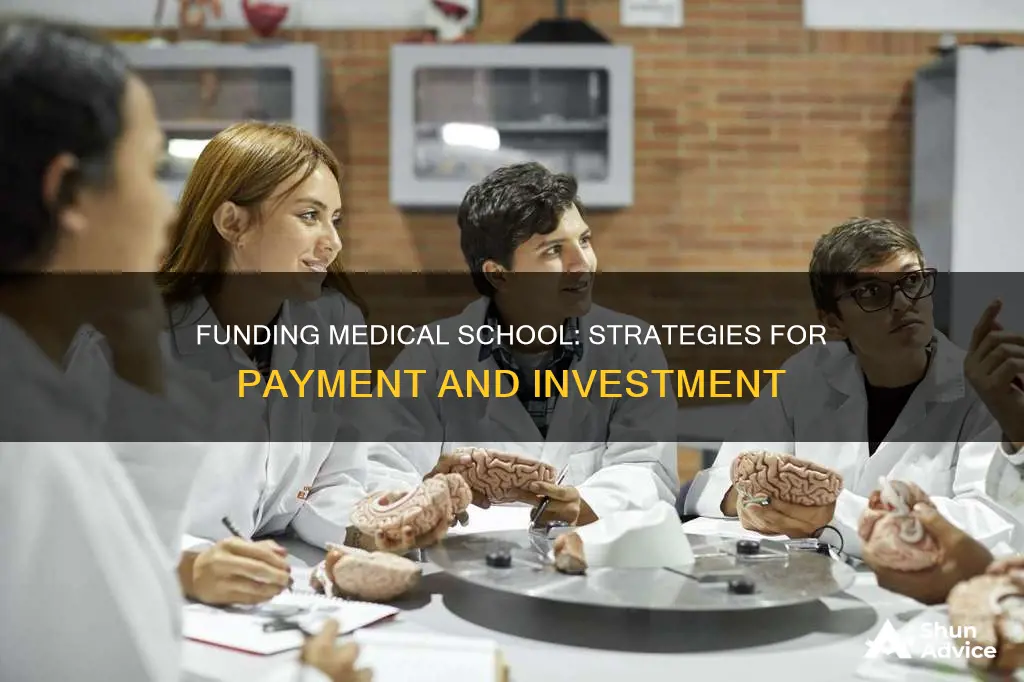
Paying for medical school and making investments as a student can be a challenging task. Medical school is expensive, and most students will need to take out loans to cover the cost of attendance. Federal loans are preferable to private loans due to their flexible repayment terms and income-based repayment options. Additionally, scholarships, personal savings, and family assistance can also help finance a medical education. While it is important to focus on studies during medical school, side gigs during less intensive periods can help bring in extra income. Students can also invest in their future by maintaining their physical and mental health, which can help prevent costly medical expenses down the line.
| Characteristics | Values |
|---|---|
| Medical school costs | The median four-year cost of attendance for the class of 2022 was $268,476 for public schools and $363,836 for private schools. |
| Average student loan debt | $200,000 |
| Scholarships and grants | Scholarships and grants can come from universities, non-profit organizations, and private companies. |
| Institutional grants and scholarships | Florida State University, University of California-Los Angeles (UCLA), Columbia University, Kaiser Permanente Bernard J. Tyson School of Medicine, New York University (NYU), Weill Cornell Medicine |
| Scholarships from non-profit organizations | American Medical Women’s Association (AMWA), Herbert W. Nickens Medical Student Scholarship, Pisacano Leadership Foundation |
| Private scholarships | Panacea Financial, Tylenol Future Care Scholarship |
| Federal student loans | Federal Direct Unsubsidized, Federal Direct Grad PLUS |
| Private student loans | Citizens Bank, College Ave, Sallie Mae |
| Tuition-free programs | Cleveland Clinic Lerner College of Medicine, NYU Grossman School of Medicine, NYU Long Island School of Medicine |
| Federal and state incentive programs | Armed Forces Health Professions Scholarship Program for Physicians, Indian Health Service Health Professions Scholarship Program, National Health Service Corps (NHSC) Scholarship Program, Arkansas Rural Practice Scholarship Program, New Mexico Loan-for-Service Program |
| Loan repayment assistance programs | Centers for Disease Control and Prevention (CDC), U.S. Department of Veterans Affairs (VA) |
| Side gigs | Research, doing H&Ps for surgical centers, donating plasma, being a medic, clerking on a ward or in the ED, rideshare services, delivery services |
What You'll Learn
- Scholarships for academic performance, research interests, or underrepresented cultural backgrounds
- Student loans, including federal and private loans
- Side gigs like ridesharing, teaching, or medical consulting
- Military scholarships in exchange for service as a military doctor
- Personal savings and assistance from family

Scholarships for academic performance, research interests, or underrepresented cultural backgrounds
Scholarships are a great way to fund your medical school education without accumulating debt. There are numerous scholarship opportunities for students from diverse backgrounds, including racial and ethnic minorities, who are underrepresented in healthcare. Here are some examples of scholarships that recognise academic performance, research interests, and cultural backgrounds:
AAMC Herbert W. Nickens Medical Student Scholarships
The Association of American Medical Colleges (AAMC) awards $5,000 scholarships to five medical students annually who demonstrate leadership in addressing educational, societal, and healthcare needs, especially for racial and ethnic minorities. Applicants must be US citizens, permanent residents, or have DACA status, and be nominated by their medical schools.
American Medical Women's Association Scholarships
The American Medical Women's Association (AMWA) offers various scholarships with different eligibility criteria. Some scholarships are geared towards students with specific interests, such as travel abroad or poster presentations. Most applications require a short essay, and becoming a member of AMWA grants access to more scholarships.
The Brown Medical and Educational Society Healthcare Scholarships
This scholarship provides $5,000 to undergraduate or graduate students pursuing a degree in healthcare, including medicine, nursing, and allied health. Applicants must be from racial and ethnic minority groups, including Black/African American, Native American/American Indian, Hispanic/Latin American, or Asian/Pacific Islander, and have a minimum GPA of 2.5.
Chinese American Medical Society Scholarships
The Chinese American Medical Society (CAMS) offers $5,000 scholarships to first-, second-, and third-year medical or dental students who are current or pending CAMS Student members. Applicants should request a recommendation letter from their school's dean to include with their application.
National Medical Fellowships
National Medical Fellowships provides various scholarships and awards to students from underrepresented groups in medicine, including African American/Black, Hispanic/Latino, American Indian or Alaska Native, Asian American, Native Hawaiian, and Other Pacific Islander students. The awards recognise academic performance, financial need, and commitment to serving underserved communities.
The National Health Service Corps Scholarship Program
This scholarship program offers tuition and fee coverage for up to four years to students training for primary care health professions. In return, students must commit to working in underserved areas for two years after graduation. Applicants must be US citizens or nationals and eligible for federal employment.
United Health Foundation/NMF Diverse Medical Scholars Program
This scholarship program offers $7,000 renewable awards to second-, third-, or fourth-year medical students who identify as African American, Latino, Native American, or Asian American (Vietnamese and Cambodian only). Applicants must demonstrate a commitment to serving medically underserved communities and meet certain academic and community service requirements.
These are just a few examples of the many scholarship opportunities available for medical students. It's important to research and apply for scholarships that align with your background, interests, and career goals. Additionally, don't hesitate to reach out to your medical school and local community for further financial aid options.
Understanding Investment Management: Strategies for Success
You may want to see also

Student loans, including federal and private loans
Student Loans
Student loans are a common way to fund your medical school education. They can be a helpful tool to cover the costs of tuition, fees, and living expenses. When it comes to student loans, there are two main types: federal loans and private loans.
Federal Loans
Federal student loans are offered by the government and often have lower interest rates compared to private loans. They are designed to make higher education more accessible and typically have flexible repayment options. Federal loans usually have strict rules regarding their use, and the Department of Education makes it clear that these loans should be used for educational expenses. Federal loans can be subsidised or unsubsidised. With subsidised loans, the government pays part of the interest, leading to a lower interest rate for the borrower. This is the government's way of investing in the education of the population.
Private Loans
Private student loans, on the other hand, are offered by banks, credit unions, or other financial institutions. They often have fewer restrictions on how the funds can be used, but they tend to be more expensive, with higher interest rates, and may be harder to get approved for. Private loans are more like traditional loans, where your creditworthiness plays a significant role in determining your eligibility and the terms of the loan.
Things to Consider
When deciding between federal and private student loans, it's important to weigh the pros and cons of each. Federal loans usually offer more favourable terms, but there might be limits on the amount you can borrow. Private loans may provide more funding but at a higher cost. It's also essential to remember that student loans are intended to cover your educational expenses, and using them for investing is a legal grey area. While it might be technically possible to invest your loan money, it's a risky strategy, and you could face legal repercussions if discovered.
Additionally, investing with student loan money means you need to generate returns that exceed the interest rate on your loan to make any profit. With current loan interest rates ranging from 4.99% to 9.08%, it can be challenging to find investments that consistently outperform these rates.
Student loans are a significant financial commitment, and it's crucial to understand the terms and conditions before taking them out. While investing your student loan money is technically possible, it's generally not recommended due to the legal, ethical, and financial risks involved. It's best to use student loan funds for their intended purpose of covering your educational expenses, including tuition and living costs.
The Lucrative Side of Investment Banking: Buy or Sell?
You may want to see also

Side gigs like ridesharing, teaching, or medical consulting
Side gigs are a great way for medical students to earn some extra cash to pay off their student loans, keep their credit card balances to a minimum, and pay for conferences, interviews, and residency applications. Here are some side gigs that medical students can take up to make some money on the side:
Ridesharing
Ridesharing through apps like Uber and Lyft is a great way for medical students to make some extra cash. You can work whenever you want and wherever you want, and it's a good way to meet new people and engage in interesting conversations.
Teaching
Medical students can also take up teaching jobs, tutoring college students or high school students, particularly in STEM subjects. You can also tutor your fellow med students or work as an MCAT tutor if you scored highly on the exam. Teaching is usually a flexible and lucrative gig, and you can work independently or for an established company.
Medical Consulting
Medical students can also work as medical school admissions consultants, guiding applicants through the admissions process. Additionally, if you have good writing skills, you can work as a medical writer, creating content such as journal abstracts, policy documents, and health and wellness blog posts. Alternatively, you can work as a medical editor, focusing on formatting, proofreading, and fact-checking.
Understanding When to Hire an Investment Manager
You may want to see also

Military scholarships in exchange for service as a military doctor
If you're considering joining the military to pay for medical school, there are several scholarship opportunities available to you. The Armed Forces Health Professions Scholarship Program (HPSP) is one of the most comprehensive scholarships in the healthcare field and is offered by the Army, Navy, and Air Force. The scholarship covers tuition, fees, books, equipment, and supplies, as well as providing a monthly living stipend of around $2,000 (as of 2018-2019) to $2,870 (as of 2024). In addition, qualifying medical students are eligible for a $20,000 sign-on bonus.
The HPSP is available to both current and future medical students and does not require prior military service. However, it is important to note that HPSP recipients must commit to practicing medicine in the military after completing their medical education. The length of this commitment depends on the length of the scholarship received, with an obligation of one year of military service for each year of scholarship. For example, if you receive a four-year scholarship, you will be required to serve four years in the military after completing your medical degree.
The application process for the HPSP is competitive and includes an interview, a physical examination, and a selection process that evaluates various aspects of your application, such as leadership, extracurricular activities, fitness, and grades. It is also important to consider the unique challenges and commitments that come with joining the military, including potential deployments and frequent moves.
Another option specifically for the U.S. Army is the Uniformed Services University of Health Sciences Army Clinical Psychology Doctoral Program. This program offers a full tuition scholarship for an MD degree, along with full pay and benefits. To be eligible, you must be an active-duty or civilian applicant interested in commissioning as an active-duty officer in the Army Medical Corps.
Invest in Yourself to Make Her Invest in You
You may want to see also

Personal savings and assistance from family
Assess Your Financial Situation
Before applying to medical school, it's important to assess your financial situation and determine how much you can realistically contribute from your personal savings or with the help of your family. Be honest about your financial capabilities and create a budget that outlines expected expenses, including tuition, fees, living expenses, and other costs associated with your medical education.
Communicate with Your Family
Have open and honest conversations with your family about their ability and willingness to contribute financially to your medical education. Discuss the amount they can afford to give and whether it will be a one-time contribution or ongoing support throughout your studies. It's important to manage expectations and ensure that everyone is on the same page.
Create a Savings Plan
If you haven't already, start saving aggressively towards your medical school fund. Cut down on unnecessary expenses, and prioritize building up your savings. Consider creating a separate high-yield savings account specifically for your medical school funds to earn more interest on your savings.
Explore Tax-Advantaged Accounts
Look into tax-advantaged accounts that can help you save for education expenses. For example, you could consider a 529 plan, which offers tax benefits when saving for education costs. There are also Coverdell Education Savings Accounts and the Uniform Transfers/Gifts to Minors Act (UGMA/UTMA) accounts that can be used for education expenses.
Combine with Other Funding Sources
Personal savings and family assistance are often just one part of the puzzle when it comes to funding medical school. Don't hesitate to explore other funding sources as well, such as scholarships, grants, and student loans. Combining your personal savings with these additional funding sources can significantly reduce the financial burden of medical school.
Be Mindful of Opportunity Costs
Remember that using your personal savings or family assistance for medical school may impact other financial goals or opportunities. Weigh the benefits of paying for medical school against other potential uses for those funds, such as investing in a business or purchasing a home. Ensure that you are comfortable with the trade-offs and that you have a comprehensive understanding of the opportunity costs involved.
A Guide to Creating Your Own Investment Journal
You may want to see also







